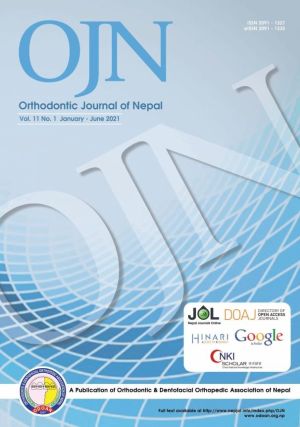Vertical Proportion of the Face: A Cephalometric study
DOI:
https://doi.org/10.3126/ojn.v11i1.39044Keywords:
Cephalometry, Lower Anterior Facial Height (LAFH), Upper Anterior Facial Height (UAFH), Vertical PatternsAbstract
Introduction: Balance in vertical facial proportion is an important criteria for good esthetics. Variations in vertical growth are common and have certain orthodontic implications. The objectives of this study were to determine mean upper anterior facial height and lower anterior facial height, ratio between UAFH to LAFH and their difference among genders in skeletal Class I patients with different vertical growth pattern among patients visiting department of Orthodontic and Dentofacial orthopedics, Tribhuvan University Dental Teaching Hospital, Kathmandu.
Materials and Method: This study was descriptive observational cross sectional study with 105 sample aged from 18-25 years. Pretreatment cephalometric radiograph of Skeletal Class I patients were taken and divided into three growth patterns as group I (normal growth pattern), group II (horizontal growth pattern ) and group III (vertical growth pattern ). Upper anterior facial height (N-ANS) and lower anterior facial height (ANS-Me) of all samples were measured on lateral cephalogram with cephalometric tracing ruler parallel to true vertical line. Descriptive statistics was used to calculate mean, minimum, and maximum values standard deviations with p value <0.05.
Result: The upper anterior facial height (UAFH) and lower anterior facial height (LAFH) measurements in normal growth pattern was 52.37 and 64.4 , in horizontal growth pattern was 53.0 and 62.2, in vertical growth pattern was 53.37 and 64.42 respectively. The mean ratio of upper and lower anterior facial height in normal, horizontal and vertical growth pattern was 0.81, 0.85 and 0.79 respectively. There was no statistically significant difference in upper and lower facial heights between males and females. There was no statistically significant difference in UAFH between normal, horizontal and vertical growth pattern but statistically significant difference was observed in LAFH between groups.
Conclusion: The cephalometric values for different vertical groups in skeletal class I can be used more specifically for diagnosis and treatment planning of Nepali population.
Downloads
Downloads
Published
How to Cite
Issue
Section
License
Copyright (c) 2021 Orthodontic & Dentofacial Orthopedic Association of Nepal

This work is licensed under a Creative Commons Attribution 4.0 International License.
Copyright © held by Orthodontic & Dentofacial Orthopedic Association of Nepal
- Copyright on any research article is transferred in full to the Orthodontic & Dentofacial Orthopedic Association of Nepal upon publication in the journal. The copyright transfer includes the right to reproduce and distribute the article in any form of reproduction (printing, electronic media or any other form).
- Articles in the Orthodontic Journal of Nepal are Open Access articles published under the Creative Commons CC BY License (https://creativecommons.org/licenses/by/4.0/)
- This license permits use, distribution and reproduction in any medium, provided the original work is properly cited.




